Magnetism in Your Daily Life
Every morning when you use your smartphone’s compass to find directions, stick a note on your refrigerator, or tap your credit card for payment, you’re experiencing the incredible world of magnetism and matter. But have you ever wondered why some materials are attracted to magnets while others aren’t? Why does iron get magnetized but copper doesn’t?
Welcome to Chapter 5 of CBSE Class 12 Physics – a fascinating journey into how different materials respond to magnetic fields. This isn’t just theory you’ll forget after exams. From MRI machines that save lives to the magnetic storage in your laptop, understanding magnetism and matter opens doors to comprehending the technology that surrounds us.
Think about it: Earth itself is a giant magnet that has been guiding travelers for centuries. The Aurora Borealis dancing across polar skies? That’s charged particles interacting with Earth’s magnetic field. Even your body contains iron that responds to strong magnetic fields – that’s how MRI scanners can peek inside you without surgery.
This chapter will transform your understanding of materials from the atomic level up, showing you why a paperclip jumps toward a magnet but a piece of aluminum barely moves. You’ll discover the hidden magnetic properties in everything around you and learn to predict how different substances behave in magnetic fields.
Learning Objectives: Your Roadmap to Mastery
By the end of this comprehensive guide, you’ll confidently:
- Classify any material as diamagnetic, paramagnetic, or ferromagnetic based on its atomic structure
- Calculate magnetic susceptibility and permeability for different materials
- Explain why ferromagnetic materials can become permanent magnets
- Analyze hysteresis loops and determine energy losses in magnetic materials
- Solve complex numerical problems involving Earth’s magnetic field elements
- Design experiments to measure magnetic properties of materials
- Connect magnetic concepts to real-world applications in technology and medicine
- Score maximum marks in CBSE board exam questions on magnetism and matter
Real-World Physics: Did you know that birds navigate using Earth’s magnetic field? They have magnetic crystals in their beaks that act like biological compasses, helping them migrate thousands of miles with pinpoint accuracy.
Section 1: The Atomic Foundation of Magnetism
Understanding Magnetic Behavior from Atoms Up
Every atom is essentially a tiny magnet, but most materials don’t appear magnetic. This seeming contradiction holds the key to understanding magnetism and matter. Let’s start with what makes an atom magnetic.
When electrons orbit the nucleus, they create tiny circular currents. According to Ampère’s law, any current loop generates a magnetic field, making each orbiting electron a microscopic magnet. Additionally, electrons possess an intrinsic property called spin, which contributes another magnetic moment.
[EQUATION: Orbital Magnetic Moment: μₗ = -μB√[l(l+1)] where μB = eh/4πmₑ = 9.27 × 10⁻²⁴ A⋅m² (Bohr magneton)]
[EQUATION: Spin Magnetic Moment: μₛ = -gₛμB√[s(s+1)] where gₛ ≈ 2 and s = ½ for electrons]
The crucial insight is this: in atoms with completely filled electron shells, all magnetic moments cancel out perfectly. It’s like having equal numbers of people walking clockwise and counterclockwise around a track – the net effect is zero motion.
Physics Check: Can you explain why helium (atomic number 2) with its two electrons in the 1s orbital shows no net magnetic moment?
The Three Magnetic Personalities
Based on how atoms combine their magnetic moments, all materials fall into three distinct categories:
Diamagnetic Materials have no unpaired electrons. When you apply a magnetic field, it induces tiny currents that oppose the field (Lenz’s law in action). These materials are weakly repelled by magnets.
Paramagnetic Materials contain unpaired electrons, giving them permanent atomic magnetic moments. However, thermal motion randomizes these orientations, so they show only weak attraction to magnets.
Ferromagnetic Materials not only have unpaired electrons but also exhibit a quantum mechanical exchange interaction that aligns neighboring atomic magnets even without external fields.
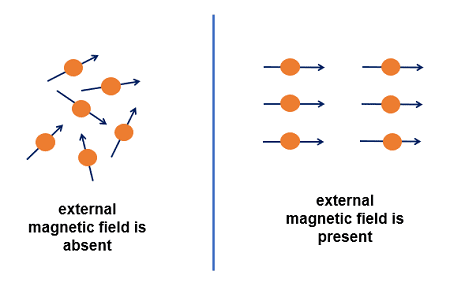
[INSERT DIAGRAM: Three atomic representations showing paired electrons (diamagnetic), unpaired electrons randomly oriented (paramagnetic), and aligned unpaired electrons (ferromagnetic)
Section 2: Mathematical Framework of Magnetic Materials
Magnetic Susceptibility – The Material’s Magnetic Fingerprint
Magnetic susceptibility (χ) tells you exactly how a material responds to magnetic fields. It’s defined as the ratio of magnetization to the magnetic field intensity:
[EQUATION: χ = M/H where M is magnetization (magnetic moment per unit volume) and H is magnetic field intensity]
For different materials:
- Diamagnetic: χ < 0 (typically -10⁻⁶ to -10⁻⁵)
- Paramagnetic: χ > 0 (typically +10⁻⁶ to +10⁻³)
- Ferromagnetic: χ >> 1 (can be 1000 or higher)
Real-World Physics: Bismuth has one of the strongest diamagnetic responses (χ = -1.66 × 10⁻⁴). Small bismuth objects can actually levitate above strong neodymium magnets due to diamagnetic repulsion!
Magnetic Permeability – How Fields Penetrate Materials
Magnetic permeability (μ) measures how easily magnetic field lines can pass through a material:
[EQUATION: μ = μ₀(1 + χ) where μ₀ = 4π × 10⁻⁷ H/m is the permeability of free space]
[EQUATION: Relative Permeability: μᵣ = μ/μ₀ = (1 + χ)]
This relationship reveals why transformer cores use ferromagnetic materials – their high permeability concentrates magnetic field lines, increasing efficiency dramatically.
The Curie Law for Paramagnetic Materials
Pierre Curie discovered that paramagnetic susceptibility follows a simple temperature relationship:
[EQUATION: Curie’s Law: χ = C/T where C is the Curie constant and T is absolute temperature]
This happens because higher temperatures increase random thermal motion, disrupting the alignment of magnetic dipoles with external fields.
Historical Context: Pierre Curie’s 1895 discovery of the temperature dependence of magnetism was groundbreaking. He showed that magnetic properties aren’t fixed but change predictably with temperature, laying groundwork for modern magnetic materials science.
Section 3: Diamagnetism – Nature’s Subtle Opposition
The Lenz’s Law Connection
Diamagnetism exists in all materials but is often masked by stronger magnetic effects. When you apply a magnetic field to any material, it induces circulating currents in electron orbits that create magnetic fields opposing the applied field.
Think of diamagnetism like a magnetic version of Newton’s third law – every magnetic action creates an equal and opposite magnetic reaction.
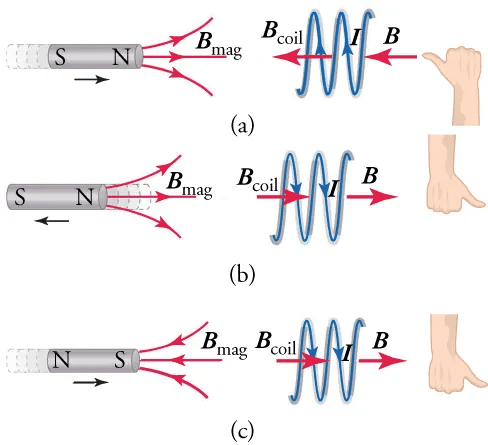
[INSERT DIAGRAM: Electron orbital showing induced current loops opposing applied magnetic field, with arrows indicating field directions
Properties of Diamagnetic Materials
Common Error Alert: Students often think diamagnetic materials are “non-magnetic.” Actually, they’re magnetic but weakly repelled by magnets. The repulsion is so weak you need sensitive equipment to detect it.
Key Characteristics:
- Negative magnetic susceptibility (χ < 0)
- Independent of temperature
- Present in all materials (but may be overwhelmed by para/ferromagnetism)
- Examples: copper, gold, silver, water, organic compounds, superconductors
Problem-Solving Strategy: When calculating diamagnetic effects, remember that χ values are small and negative. Always check that your final answer shows field reduction inside the material.
Superconductors – Perfect Diamagnets
Superconductors exhibit perfect diamagnetism (χ = -1), completely expelling magnetic fields from their interior. This Meissner effect enables magnetic levitation applications.
Real-World Physics: Maglev trains use superconducting magnets that levitate above the track due to perfect diamagnetic repulsion, eliminating friction and enabling speeds over 600 km/h.
Section 4: Paramagnetism – Weak Attraction with Temperature Dependence
Understanding Paramagnetic Behavior
Paramagnetic materials contain atoms with unpaired electrons, giving them permanent magnetic dipoles. Without an external field, thermal motion randomizes these orientations, producing zero net magnetization.
When you apply a magnetic field, it tries to align these atomic magnets, but thermal energy opposes this alignment. The result is weak attraction to magnets that decreases with increasing temperature.
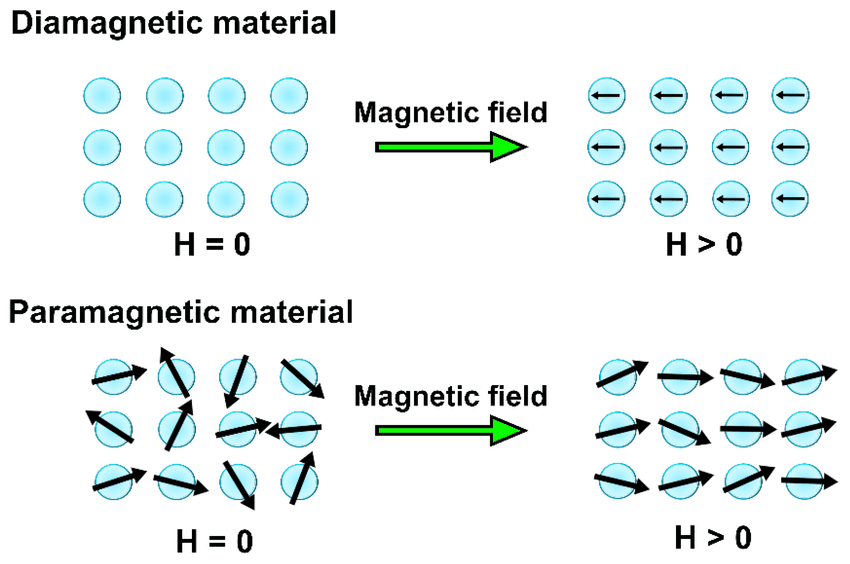
[INSERT DIAGRAM: Paramagnetic material showing randomly oriented atomic dipoles without field, and partially aligned dipoles with applied field
The Mathematics of Paramagnetic Alignment
For weak magnetic fields (the usual case), the magnetization of a paramagnetic material follows:
[EQUATION: M = (n μ₀ μ²ₐₜₒₘ H)/(3 kᵦT) where n is number density of atoms, μₐₜₒₘ is atomic magnetic moment, kᵦ is Boltzmann constant]
This leads directly to Curie’s law when we define χ = M/H.
Physics Check: Why does paramagnetic susceptibility decrease with temperature? Think about the competition between magnetic alignment energy and thermal randomization energy.
Applications of Paramagnetic Materials
Oxygen Analysis: Paramagnetic oxygen is used in gas analyzers. Since O₂ molecules have unpaired electrons, they’re attracted to magnetic field gradients, allowing precise oxygen concentration measurements.
MRI Contrast Agents: Gadolinium-based contrast agents are paramagnetic, altering the magnetic environment around tissues to enhance image contrast in medical scans.
Section 5: Ferromagnetism – The Powerhouse of Magnetic Technology
Domain Theory and Exchange Interaction
Ferromagnetic materials are the superstars of magnetism. They don’t just respond to magnetic fields; they can maintain their own magnetization indefinitely. The secret lies in magnetic domains – regions where atomic magnetic moments align parallel due to quantum mechanical exchange forces.
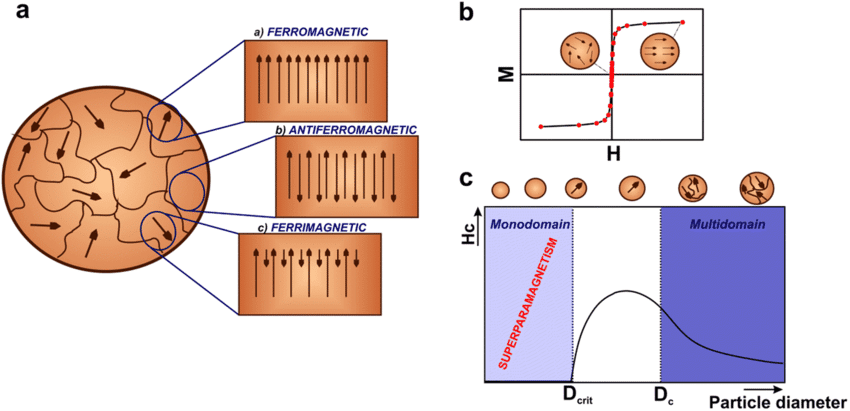
[INSERT DIAGRAM: Ferromagnetic material showing domain structure with arrows indicating magnetization directions in different domains, separated by domain walls
Without an applied field, domains orient randomly to minimize magnetostatic energy. When you apply a field, two processes occur:
- Domain wall motion: Favorably oriented domains grow at the expense of others
- Domain rotation: Domain magnetizations rotate toward the field direction
The Curie Temperature Transition
Every ferromagnetic material has a critical temperature (Curie temperature, Tᶜ) above which it becomes paramagnetic. This happens because thermal energy overcomes the exchange interaction that maintains domain alignment.
[EQUATION: For T > Tᶜ: χ = C/(T – Tᶜ) – Curie-Weiss Law]
Examples of Curie Temperatures:
- Iron: 1043 K (770°C)
- Nickel: 631 K (358°C)
- Cobalt: 1404 K (1131°C)
Real-World Physics: Curie temperature sensors use this property for temperature measurement and fire detection. When temperature exceeds Tᶜ, ferromagnetic elements lose their magnetism, triggering safety systems.
Soft vs Hard Magnetic Materials
Soft Magnetic Materials (easy to magnetize/demagnetize):
- Narrow hysteresis loops
- Low coercivity (Hᶜ < 1000 A/m)
- Applications: transformer cores, electromagnets, motors
Hard Magnetic Materials (retain magnetization strongly):
- Wide hysteresis loops
- High coercivity (Hᶜ > 10,000 A/m)
- Applications: permanent magnets, magnetic storage media
Section 6: Hysteresis – The Memory of Magnetic Materials
Understanding the Hysteresis Loop
When you cycle a ferromagnetic material through increasing and decreasing magnetic fields, the relationship between magnetic field intensity (H) and magnetic flux density (B) traces a characteristic loop called a hysteresis curve.
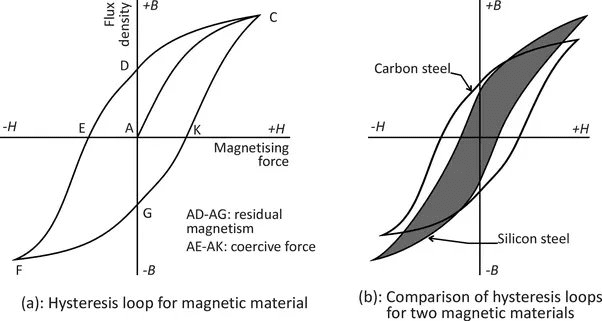
[INSERT DIAGRAM: Complete hysteresis loop showing saturation magnetization, remanence, coercivity, and energy loss area, with clearly labeled axes B vs H
Key Parameters:
- Saturation (Bₛₐₜ): Maximum possible magnetization
- Remanence/Retentivity (Bᵣ): Residual magnetization when H = 0
- Coercivity (Hᶜ): Reverse field needed to reduce B to zero
[EQUATION: Energy dissipated per cycle = ∮ H⋅dB = Area enclosed by hysteresis loop]
Applications Based on Hysteresis Properties
Transformer Cores require materials with narrow hysteresis loops to minimize energy losses during AC operation. Silicon steel is optimized for this application.
Permanent Magnets need wide hysteresis loops with high coercivity to resist demagnetization. Modern neodymium-iron-boron magnets can maintain their magnetization for decades.
Magnetic Storage uses materials where the two directions of remanent magnetization represent binary data (0 and 1).
Problem-Solving Strategy: When analyzing hysteresis problems, always identify whether you’re dealing with soft or hard magnetic materials first. This determines which part of the loop is most important for the application.
Section 7: Earth’s Magnetism – Our Planetary Magnetic Shield
Magnetic Elements and Navigation
Earth behaves like a giant bar magnet with its magnetic axis tilted about 11° from the geographic axis. At any location on Earth, the magnetic field can be completely described by three magnetic elements:
[EQUATION: Total Field Components: B² = Bₕ² + Bᵥ² where Bₕ is horizontal component, Bᵥ is vertical component]
[EQUATION: Magnetic Dip: tan I = Bᵥ/Bₕ where I is the angle of inclination or dip]
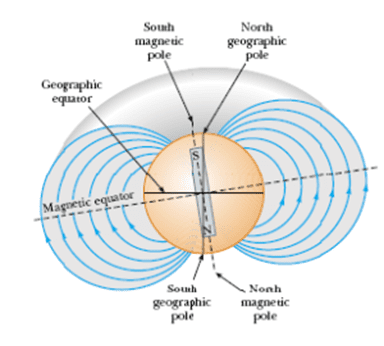
[INSERT DIAGRAM: Earth’s magnetic field lines showing geographic poles, magnetic poles, declination angle, and inclination angle at a specific location
The Three Key Angles
- Declination (D): Angle between magnetic north and geographic north
- Inclination/Dip (I): Angle between field direction and horizontal plane
- Total field magnitude and components
Real-World Physics: GPS systems must constantly update magnetic declination data because Earth’s magnetic field changes over time due to movements in the molten iron core. Declination can vary by several degrees over decades.
Magnetic Maps and Secular Variation
Earth’s magnetic field isn’t constant – it changes slowly over time (secular variation) and occasionally reverses completely. Paleomagnetic studies show that magnetic reversals happen roughly every 200,000 to 300,000 years.
Historical Context: The Chinese discovered magnetic declination over 1000 years ago, noting that compass needles didn’t point to true north. This discovery was crucial for accurate navigation and mapmaking.
Section 8: Laboratory Investigations and Measurement Techniques
Measuring Magnetic Susceptibility – Gouy’s Method
The most common method for measuring magnetic susceptibility uses Gouy’s balance, which measures the apparent change in weight of a sample placed in a non-uniform magnetic field.
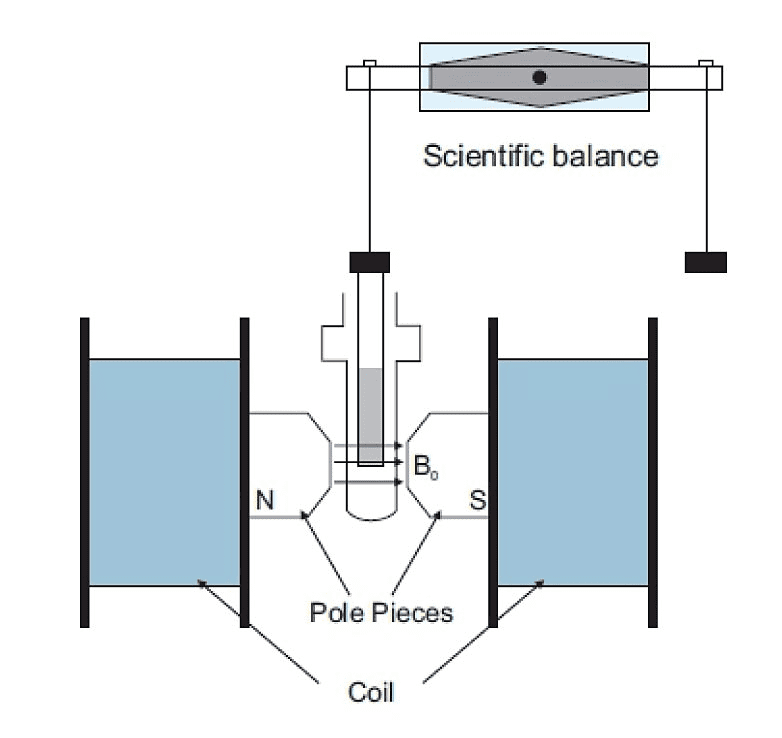
[INSERT DIAGRAM: Gouy’s balance setup showing sample tube suspended between electromagnet poles, with sensitive balance measuring weight changes
Experimental Procedure:
- Measure sample weight without magnetic field (W₁)
- Apply strong non-uniform magnetic field
- Measure new apparent weight (W₂)
- Calculate susceptibility from weight change
[EQUATION: χ = (2ΔW g)/(ρ A B² μ₀) where ΔW = W₂ – W₁, ρ is density, A is cross-sectional area, g is gravitational acceleration]
Plotting B-H Curves
To obtain hysteresis loops experimentally:
Equipment Needed:
- Toroidal core sample with primary and secondary windings
- Variable current source for primary coil
- Integrating circuit for secondary coil
- Oscilloscope or data acquisition system
Key Measurements:
- Primary current determines H field
- Secondary voltage integration gives B field
- Plot B vs H while cycling current
Error Analysis: Account for air gap effects, temperature variations, and eddy current losses in the sample. Proper calibration requires known reference materials.
Determining Curie Temperature
Experimental Design:
- Heat ferromagnetic sample gradually while monitoring susceptibility
- Note temperature where χ drops sharply (transition to paramagnetic)
- Above Tᶜ, verify that susceptibility follows Curie-Weiss law
- Use multiple heating/cooling cycles to ensure reproducibility
Section 9: Advanced Applications in Modern Technology
Magnetic Resonance Imaging (MRI)
MRI exploits the magnetic properties of hydrogen nuclei in water molecules. When placed in strong magnetic fields (1-3 Tesla), these nuclear magnetic moments align with the field.
Technical Principle: Radio frequency pulses tip these aligned nuclei, and their relaxation back to equilibrium produces detectable signals. Different tissues have different relaxation times, creating image contrast.
Real-World Physics: MRI machines use superconducting electromagnets cooled with liquid helium to generate ultra-stable magnetic fields. Even tiny field variations would blur images, so magnetic shielding is critical.
Spintronics and Quantum Technology
Modern electronics increasingly exploits electron spin rather than just charge. Spintronic devices like giant magnetoresistance (GMR) sensors revolutionized computer hard drives by dramatically increasing storage density.
Future Applications:
- Quantum computers using magnetic quantum dots
- Spin-based memory devices (MRAM)
- Magnetic logic circuits for ultra-low power electronics
Magnetic Separation and Purification
Industries use magnetic properties for separation processes:
- Iron ore processing: Separating magnetic iron minerals from non-magnetic gangue
- Recycling: Separating ferrous from non-ferrous metals
- Biotechnology: Using magnetic nanoparticles to isolate specific proteins or cells
Section 10: Comprehensive Problem-Solving Guide
Problem Type 1: Magnetic Susceptibility and Permeability Calculations
Sample Problem: A paramagnetic rod has magnetic susceptibility 3.7 × 10⁻⁴. When placed in a magnetic field of 0.8 T, find: (a) relative permeability, (b) magnetization, (c) magnetic field inside the rod.
Step-by-Step Solution:
(a) Relative Permeability:
μᵣ = 1 + χ = 1 + 3.7 × 10⁻⁴ = 1.00037
(b) Magnetization:
First find H: H = B/μ₀ = 0.8/(4π × 10⁻⁷) = 6.37 × 10⁵ A/m
Then: M = χH = 3.7 × 10⁻⁴ × 6.37 × 10⁵ = 235.7 A/m
(c) Magnetic Field Inside:
B_inside = μ₀(H + M) = μ₀H + μ₀M = 0.8 + (4π × 10⁻⁷ × 235.7) = 0.8003 T
Problem Type 2: Earth’s Magnetic Field Elements
Sample Problem: At a location, horizontal component of Earth’s field is 2 × 10⁻⁵ T and dip angle is 45°. Find the total magnetic field and vertical component.
Solution:
Given: Bₕ = 2 × 10⁻⁵ T, I = 45°
Vertical component: Bᵥ = Bₕ tan I = 2 × 10⁻⁵ × tan 45° = 2 × 10⁻⁵ T
Total field: B = Bₕ/cos I = 2 × 10⁻⁵/cos 45° = 2 × 10⁻⁵/0.707 = 2.83 × 10⁻⁵ T
Physics Check: At 45° dip, vertical and horizontal components should be equal, which our answer confirms.
Problem Type 3: Hysteresis and Energy Loss
Sample Problem: A ferromagnetic core operates in an AC magnetic field. If the hysteresis loop has area 200 J/m³ per cycle and the core volume is 0.01 m³, find energy dissipated per second at 50 Hz.
Solution:
Energy per cycle = Area × Volume = 200 × 0.01 = 2 J/cycle
Power = Energy per cycle × Frequency = 2 × 50 = 100 W
Problem Type 4: Temperature Effects on Magnetic Properties
Sample Problem: A paramagnetic material follows Curie’s law with C = 0.8 K. Find the ratio of susceptibilities at 300 K and 600 K.
Solution:
χ₁/χ₂ = (C/T₁)/(C/T₂) = T₂/T₁ = 600/300 = 2
The susceptibility at 300 K is twice that at 600 K, showing how thermal motion reduces magnetic alignment.
Section 11: Practice Problems Collection
Multiple Choice Questions with Detailed Solutions
Q1: Which material would show the strongest diamagnetic response?
(a) Copper (b) Bismuth (c) Aluminum (d) Iron
Answer: (b) Bismuth
Detailed Explanation: Bismuth has χ = -1.66 × 10⁻⁴, the strongest diamagnetic response among common elements. Copper is also diamagnetic but weaker (χ ≈ -10⁻⁵). Aluminum is paramagnetic, and iron is ferromagnetic.
Q2: The magnetic susceptibility of a material is -0.5 × 10⁻⁵. The material is:
(a) Ferromagnetic (b) Paramagnetic (c) Diamagnetic (d) Cannot be determined
Answer: (c) Diamagnetic
Detailed Explanation: Negative susceptibility is the defining characteristic of diamagnetic materials. The magnitude (10⁻⁵) is typical for diamagnetic substances.
Q3: At the magnetic equator, Earth’s magnetic field:
(a) Is purely horizontal (b) Is purely vertical (c) Has equal horizontal and vertical components (d) Is zero
Answer: (a) Is purely horizontal
Detailed Explanation: At the magnetic equator, the dip angle I = 0°, so Bᵥ = Bₕ tan 0° = 0. The field is entirely horizontal.
Free Response Problems with Complete Solutions
Problem 1: A toroidal electromagnet has a ferromagnetic core with relative permeability 2000. The electromagnet has 500 turns carrying 2 A current. If the mean path length through the core is 0.3 m, find:
(a) Magnetic field intensity H in the core
(b) Magnetic flux density B in the core
(c) Magnetization M of the core material
Complete Solution:
(a) Magnetic Field Intensity:
Using Ampère’s law for toroidal geometry:
H = NI/(2πr_avg) ≈ NI/l_path = (500 × 2)/0.3 = 3333 A/m
(b) Magnetic Flux Density:
B = μ₀μᵣH = 4π × 10⁻⁷ × 2000 × 3333 = 8.38 T
(c) Magnetization:
M = χH = (μᵣ – 1)H = (2000 – 1) × 3333 = 6.66 × 10⁶ A/m
Problem 2: Design an experiment to distinguish between paramagnetic and diamagnetic liquids using simple laboratory equipment.
Experimental Design:
Objective: Differentiate paramagnetic from diamagnetic liquids
Materials: Strong permanent magnet, glass tubes, various liquid samples, sensitive balance or visual observation setup
Procedure:
- Fill identical glass tubes with test liquids
- Suspend tubes horizontally near magnet pole
- Observe deflection direction:
- Paramagnetic liquids: Attracted toward magnet
- Diamagnetic liquids: Repelled from magnet
Controls: Test known paramagnetic (liquid oxygen, if available) and diamagnetic (water) samples first
Quantitative Enhancement: Use Gouy balance method to measure actual susceptibility values
Safety: Ensure strong magnets don’t interfere with electronic devices; handle glass tubes carefully
Section 12: Exam Success Strategies and Common Pitfalls
High-Frequency Exam Topics
Based on CBSE exam patterns, these topics appear most frequently:
- Classification of magnetic materials (40% of questions)
- Magnetic susceptibility calculations (25% of questions)
- Earth’s magnetic elements (20% of questions)
- Curie temperature and temperature effects (10% of questions)
- Hysteresis applications (5% of questions)
Common Mistakes and Prevention Strategies
Mistake 1: Confusing signs of magnetic susceptibility
Prevention: Remember “DPF” – Diamagnetic (negative), Paramagnetic (positive small), Ferromagnetic (positive large)
Mistake 2: Incorrect unit conversions between B and H
Prevention: Always write B = μ₀H in vacuum, B = μ₀μᵣH in materials
Mistake 3: Misinterpreting hysteresis loop parameters
Prevention: Practice sketching loops and identifying remanence, coercivity, and saturation points
Mistake 4: Wrong application of Curie’s law
Prevention: Remember Curie’s law applies only to paramagnetic materials above their Curie temperature
Time Management for Different Question Types
2-mark questions (Definition/Classification): 2-3 minutes each
- Focus on clear definitions and examples
- Use proper scientific terminology
3-mark questions (Numerical problems): 4-5 minutes each
- Show all steps clearly
- Include proper units throughout
- State final answer explicitly
5-mark questions (Derivations/Applications): 8-10 minutes each
- Start with basic principles
- Show mathematical steps logically
- Connect to real-world applications
Conclusion: Mastering Magnetism for Academic and Career Success
Congratulations! You’ve journeyed through the fascinating world of magnetism and matter, from atomic magnetic moments to Earth’s protective magnetic shield. This chapter isn’t just about passing exams – it’s your introduction to understanding the magnetic technologies that power our modern world.
Every time you use magnetic storage, navigate with GPS, get an MRI scan, or even stick a note to your refrigerator, you’re witnessing the principles you’ve mastered here. The classification skills you’ve developed help engineers choose materials for everything from transformer cores to permanent magnets in electric vehicles.
Key Conceptual Takeaways:
- All materials respond to magnetic fields, but in distinctly different ways based on their atomic structure
- Temperature plays a crucial role in magnetic behavior, with thermal energy competing against magnetic alignment
- Ferromagnetic materials’ ability to maintain magnetization makes most magnetic technology possible
- Earth’s magnetic field, while seemingly simple, involves complex three-dimensional field geometry
Mathematical Mastery Achieved:
You can now calculate magnetic susceptibility, permeability, and field strengths in different materials. You understand the temperature dependencies described by Curie’s law and can analyze hysteresis loops to determine energy losses in magnetic systems.
Problem-Solving Skills Developed:
Your systematic approach to magnetism problems – identifying material type, choosing appropriate equations, and checking answer reasonableness – will serve you well in engineering and physics courses ahead.
Real-World Connections:
From MRI machines using superconducting magnets to the magnetic separation processes in recycling facilities, you can now appreciate the physics behind technologies that improve our lives daily.
Future Learning Pathways:
This foundation prepares you for advanced topics in electromagnetism, quantum mechanics, and materials science. In university physics and engineering courses, you’ll explore quantum origins of magnetism, advanced magnetic materials, and cutting-edge applications in quantum computing and spintronics.
Final Exam Strategy:
Remember that magnetism problems often connect to other physics topics. Don’t just memorize formulas – understand the underlying physics so you can adapt to novel problem scenarios in your board exam.
As you continue your physics journey, carry with you the wonder that motivated scientists like Curie, Faraday, and Maxwell. The magnetic phenomena you’ve studied here continue to reveal new secrets, from magnetic monopoles in exotic materials to the magnetic fields of distant galaxies.
The invisible magnetic forces you now understand are among the fundamental interactions that shaped our universe and continue to drive technological innovation. Your mastery of these concepts opens doors to careers in physics, engineering, medicine, and emerging fields we can barely imagine today.
Good luck with your CBSE board examination! Your deep understanding of magnetism and matter will serve you well not just in scoring excellent marks, but in appreciating the magnetic world around you for years to come.
This comprehensive study guide provides everything needed to excel in CBSE Class 12 Physics Chapter 5. Continue practicing problems, connecting concepts to real-world phenomena, and maintaining curiosity about the magnetic forces that surround us every day.
Recommended –


1 thought on “Magnetism and Matter Class 12 Notes: NCERT Solutions, Important Questions for CBSE Board Exams 2026”